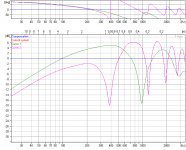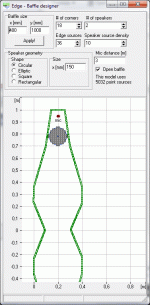8" on narrow baffle is fine up to 2khz. I'd worry more about the breakup harmonics at lower freq. than dispersion.
http://www.diyaudio.com/forums/multi-way/155632-s12-ob-returning-true-ob-4.html
I've built dipoles with small midbass. They're great when crossed relatively high (160-200hz). But yeah.. try feeding them 160Hz tone at sufficient level and you'd hear the distortion. Not really audible on music but knowing is sometimes not good 🙂
Gainphile: S9 Open Baffle Speakers
L16 would make a good driver with such approach. ZA is better due to higher resonance.
Personally I'd go with 8" and no less. but that means low-fs tweeters and ruling out the neo.
http://www.diyaudio.com/forums/multi-way/155632-s12-ob-returning-true-ob-4.html
I've built dipoles with small midbass. They're great when crossed relatively high (160-200hz). But yeah.. try feeding them 160Hz tone at sufficient level and you'd hear the distortion. Not really audible on music but knowing is sometimes not good 🙂
Gainphile: S9 Open Baffle Speakers
L16 would make a good driver with such approach. ZA is better due to higher resonance.
Personally I'd go with 8" and no less. but that means low-fs tweeters and ruling out the neo.
It depends on your requirements for dispersion and crossover points and slopes. I'd agree with Gainphile on up to 2kHz and cone breakup management, but keep in mind vertical dispersion is a function of the size of the radiating surface as well and needs to be taken into account as well if you want a clean radiation pattern from a point source speaker.I see your point, but doesn't that come at the expense of worse horizontal dispersion when compared to smaller drivers?
The dipole peak of a nude eight inch will be around 1250Hz. Adding baffle will move the peak lower. If you want truly clean directvity that means crossing enough below the dipole peak that minimal power is radiated at the increasingly directional frequencies above the peak. LR6 at 600-700Hz would be a good starting point for a nude eight.
Depends on what wowo101 ends up doing with the bass. But if you want a three way with a ripole you'll need a long throw eight to cross low enough to get good dispersion from the ripole. Take a look at the driver compromises Linkwitz had to resort to in the Orion and you'll see what I mean.Personally I'd go with 8" and no less. but that means low-fs tweeters and ruling out the neo.
Personally I find the directionality limitations of taking even a nude eight to 2kHz quite audible and wouldn't exactly recommend it. But avoiding that requires a different approach to three way bass. Personally I'd default to something like a Peerless 830669 or AE Speakers Dipole12 on as little baffle as you can get away with and try to cross at 350-400Hz. That would probably get you close to Neo10 range (pretty decent horizontal directivity, good backwave pattern, not so good vertically crossing to the Neo3) and should allow a six inch dynamic driver (better vertically, worse on the rest). If your SPL requirements call for multiple 12s you'll likely hit vertical dispersion problems and excursion problems on the mid though.
Or you could just skip the three way dipole contortions and do a four way. 😛
I know I'm getting ahead of myself by asking this, but I'm too thrilled by all your input to restrain myself... ;-)
Shouldn't the L16 be capable enough at the low end to be crossed quite low to the ripole, considering its extremely long throw (for an almost six, that is) and the fact that in a closed box (SL's Pluto) it's being used down to 40 Hz? (Then again, maybe I'm just trying to rationalize my decision to go ahead with what I have...)
Second question: I've already bought (very cheap, I have to add) four 10" Peerless SLS for the planned ripoles - do you think they would also work as woofers on a simple OB (or maybe an H- or U-frame)? SL's SPL sheet gave me something between 35 and 50 Hz for a single driver and my 85 dB SPL target, counting in floor bounce a.k.a. 2pi space instead of free space. (I guess it's european SPL targets time again!)
Of course, in the end, there's always the possibility to go four way... 😛
Thanks for all your input so far!
Shouldn't the L16 be capable enough at the low end to be crossed quite low to the ripole, considering its extremely long throw (for an almost six, that is) and the fact that in a closed box (SL's Pluto) it's being used down to 40 Hz? (Then again, maybe I'm just trying to rationalize my decision to go ahead with what I have...)
Second question: I've already bought (very cheap, I have to add) four 10" Peerless SLS for the planned ripoles - do you think they would also work as woofers on a simple OB (or maybe an H- or U-frame)? SL's SPL sheet gave me something between 35 and 50 Hz for a single driver and my 85 dB SPL target, counting in floor bounce a.k.a. 2pi space instead of free space. (I guess it's european SPL targets time again!)
Of course, in the end, there's always the possibility to go four way... 😛
Thanks for all your input so far!
Hey, some of us in America use unAmerican (or at least unTexan) SPL targets too. 😛 I don't see a problem using a pair of 830668s for bass if all you're after is 85-90dB SPL. Run nude they're only a couple dB below what I'm designing to and it wouldn't take much of a baffle to add a few more dB. Try running them in a nude, swinging, push/pull configuration before you bother with a baffle. I would guess you could probably cross nude L16s in the range of 150-200Hz LR6, lower with baffle. Again, I'd suggest trying nude first and moving to a baffle only if you need more SPL or a lower cross at lower distortion.
I've had good results with Linkwitz's power/excursion limited SPL spreadsheet. Keep in mind xmax implies 10% THD, so a smaller number is important if clean peaks are a consideration---I've been using xmax/4 as a starting point but have been finding that's a little aggressive; you may want to design to xmax/5 or xmax/6. John Janowitz's suggestion of equalizing flat to 30Hz for good bass authority is well taken as well (John runs AE Speakers).
I've had good results with Linkwitz's power/excursion limited SPL spreadsheet. Keep in mind xmax implies 10% THD, so a smaller number is important if clean peaks are a consideration---I've been using xmax/4 as a starting point but have been finding that's a little aggressive; you may want to design to xmax/5 or xmax/6. John Janowitz's suggestion of equalizing flat to 30Hz for good bass authority is well taken as well (John runs AE Speakers).
Last edited:
Thanks, twest820, for the recommendations! Peerless drivers and DCX will arrive soon, amp parts are already here, so I'm just a few inches away from trying out things myself. Will post results as soon as I've got something real to show.
Finally: 2 of 3 ways
So I finally came around to do a test integration of the SEAS L16 and the Neo3. After playing around with crossover points and slopes, EQ and mounting schemes for a while, I came up with the following measurements (XO 200 Hz and 1.6 kHz LR48, gated measurements at 1 m, 15° steps):
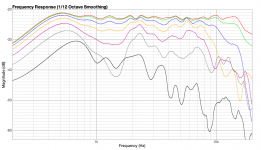
While the overall picture is not too bad with some expected drawbacks of the setup (increased directivity at the L16's upper end, diffraction effects around 6 kHz), there's one thing I don't understand:
Around 2.3 kHz directivity increases quite considerably. This doesn't seem to be caused by lobing - the effect is visible even when running the Neo3 alone. I couldn't get rid of it by moving the drivers to the top of the improvised stand and by surrounding the L16's spider, magnet and mounting with open cell foam, so it doesn't seem to be caused by reflections of the back wave either. I was looking around for other objects in the relevant distance which could cause reflections or diffractions, but found none.
Does anyone have an idea what could be the cause? Am I completely overlooking something? Or am I just being too critical about an otherwise fine frequency response?
So I finally came around to do a test integration of the SEAS L16 and the Neo3. After playing around with crossover points and slopes, EQ and mounting schemes for a while, I came up with the following measurements (XO 200 Hz and 1.6 kHz LR48, gated measurements at 1 m, 15° steps):

While the overall picture is not too bad with some expected drawbacks of the setup (increased directivity at the L16's upper end, diffraction effects around 6 kHz), there's one thing I don't understand:
Around 2.3 kHz directivity increases quite considerably. This doesn't seem to be caused by lobing - the effect is visible even when running the Neo3 alone. I couldn't get rid of it by moving the drivers to the top of the improvised stand and by surrounding the L16's spider, magnet and mounting with open cell foam, so it doesn't seem to be caused by reflections of the back wave either. I was looking around for other objects in the relevant distance which could cause reflections or diffractions, but found none.
Does anyone have an idea what could be the cause? Am I completely overlooking something? Or am I just being too critical about an otherwise fine frequency response?
Around 2.3 kHz directivity increases quite considerably. This doesn't seem to be caused by lobing - the effect is visible even when running the Neo3 alone. I couldn't get rid of it by moving the drivers to the top of the improvised stand and by surrounding the L16's spider, magnet and mounting with open cell foam, so it doesn't seem to be caused by reflections of the back wave either. I was looking around for other objects in the relevant distance which could cause reflections or diffractions, but found none.
Does anyone have an idea what could be the cause? Am I completely overlooking something? Or am I just being too critical about an otherwise fine frequency response?
I don't see directivity increase, but decrease.😉 2.3 kHz would correspond to a half wavelength of 7.5 cm. There SHOULD be something reflecting in that distance. Do you have a picture of the measured mounting situation?
Argh, I still can't figure out which way around the term is used... 😉
The L16's magnet and the driver stand are 6-9 cm away, so they were my first guess. But covering them with 2-3 cm of Basotect didn't change the frequency response - maybe that's too little to have an effect?
Anyway - I'll take some pictures this evening and post them tomorrow.
Thanks for the guidance!
The L16's magnet and the driver stand are 6-9 cm away, so they were my first guess. But covering them with 2-3 cm of Basotect didn't change the frequency response - maybe that's too little to have an effect?
Anyway - I'll take some pictures this evening and post them tomorrow.
Thanks for the guidance!
Hi,
I have a 16,5cm midbass (and 30cm bass - both Beyma) for a OB 3-way too. I guess according to wowo101's data the null at ~400Hz that Edge predicts (pink line in the picture) won't be that bad?
Until now I still haven't measured my speaker and it sounds great! 🙂 I crossed it at 450Hz. I guess I'll try below 200Hz.
(All seems to point at 105dB at the listening position, I think that's OK.)
I have a 16,5cm midbass (and 30cm bass - both Beyma) for a OB 3-way too. I guess according to wowo101's data the null at ~400Hz that Edge predicts (pink line in the picture) won't be that bad?
Until now I still haven't measured my speaker and it sounds great! 🙂 I crossed it at 450Hz. I guess I'll try below 200Hz.
(All seems to point at 105dB at the listening position, I think that's OK.)
Sorry, do you mean 4/5 or 5/6 times Xmax? Xmax/6 is smaller than Xmax/4.I've had good results with Linkwitz's power/excursion limited SPL spreadsheet. Keep in mind xmax implies 10% THD, so a smaller number is important if clean peaks are a consideration---I've been using xmax/4 as a starting point but have been finding that's a little aggressive; you may want to design to xmax/5 or xmax/6. John Janowitz's suggestion of equalizing flat to 30Hz for good bass authority is well taken as well (John runs AE Speakers).
Attachments
Last edited:
wowo101, can you post individual response graphs for the woofer and tweeter? It almost looks like the woofer response is narrowing, then it widens back again once the tweeter takes over.
And something that was pointed out to me about my speakers, which may be relevant here - if you have any electrical delay on either driver for proper phase alignment, that will cause off-axis issues (because the physical alignment difference starts to go away, but the electrical delay is still present), often right at the crossover point. So that might be contributing to the off-axis response falloff around 1.6kHz. One more reason to get the physical alignment as close as possible before applying electrical correction.
And something that was pointed out to me about my speakers, which may be relevant here - if you have any electrical delay on either driver for proper phase alignment, that will cause off-axis issues (because the physical alignment difference starts to go away, but the electrical delay is still present), often right at the crossover point. So that might be contributing to the off-axis response falloff around 1.6kHz. One more reason to get the physical alignment as close as possible before applying electrical correction.
Last edited:
What I see in your plots is less control over directivity - it is not constant both at 1.4 and 2.3 kHz. And I see less beaming at 2.3 kHz. So it is "less" however you look at it. 😛Argh, I still can't figure out which way around the term is used... 😉
But I have to conceed that most everyone is using the word as one sees fit.
2-3 cm of Basotect are less than a quarter wavelength - much too thin. But there is an easier way: Put some piece of board in the air half way between the Neo and the reflecting surfaces. If the measured irregularity moves up one octave - bingo!The L16's magnet and the driver stand are 6-9 cm away, so they were my first guess. But covering them with 2-3 cm of Basotect didn't change the frequency response - maybe that's too little to have an effect?
Rudolf
BTW: Is that Neo mounted at the same position as the Aurasound was (front of L16 basket)? Would be less than perfect. 🙄
I guess according to wowo101's data the null at ~400Hz that Edge predicts (pink line in the picture) won't be that bad?
Please note that these are gated measurements with a window of 4 ms and a resolution of 250 Hz - thus the data in the bass range isn't really meaningful.
Sorry, do you mean 4/5 or 5/6 times Xmax? Xmax/6 is smaller than Xmax/4.
I think twest820 meant that xmax/4 is still too aggressive since it pushes the driver to distortion-critical excursion, and that the smaller xmax/5 or xmax/6 would be better choices.
Saurav - yes, the woofer starts to beam above 700 Hz. The tweeter takes over at 1.6 kHz, hence directivity control (thanks, Rudolf!) gets better above that frequency. But the (second) problematic range around 2.3 kHz is well away from that, and it stays constant independent of a lower or higher XO point. (Ah, and I didn't use electrical delay correction, I hope I'll be able to correct any deviation via proper driver placement later.)
Rudolf - thanks for the cardboard trick! I'll try that this evening. I guess I was a bit optimistic with my little Basotect application...
As to the mounting scheme: Yes, the Neo3 sits roughly in the same place as the Auras did - screwed to the backside of the L16's basket rim, using cardboard and felt. I was hoping to minimize the distance between L16 and Neo3 to avoid vertical lobing, and to be able to set back the Neo3 from the L16's basket enough to correct any delay. Where did I go wrong with this line of thinking? What would be a better alternative?
Rudolf - thanks for the cardboard trick! I'll try that this evening. I guess I was a bit optimistic with my little Basotect application...
As to the mounting scheme: Yes, the Neo3 sits roughly in the same place as the Auras did - screwed to the backside of the L16's basket rim, using cardboard and felt. I was hoping to minimize the distance between L16 and Neo3 to avoid vertical lobing, and to be able to set back the Neo3 from the L16's basket enough to correct any delay. Where did I go wrong with this line of thinking? What would be a better alternative?
Danke, wowo101! I'm a beginner builder. 🙂 (Rudolf's site is interesting too.)
Well Linktwitz did settle for Xmax/2 for the bass drivers in his Orion I, didn't he? I have to measure this too, I couldn't hear distortion at such low excursion (I did, when I pushed the bass highpass to 40Hz.). I figured "Pi mal daumen" that the mechanical requirements at lower excursion is lower too. So using 3mm out of 4mm Xmax couldn't be as bad as 10mm out 12mm for example.
Well Linktwitz did settle for Xmax/2 for the bass drivers in his Orion I, didn't he? I have to measure this too, I couldn't hear distortion at such low excursion (I did, when I pushed the bass highpass to 40Hz.). I figured "Pi mal daumen" that the mechanical requirements at lower excursion is lower too. So using 3mm out of 4mm Xmax couldn't be as bad as 10mm out 12mm for example.
Drive in a parkway, park in a driveway. Write or burn things up and down at the same time. Wonderful language, English.Argh, I still can't figure out which way around the term is used... 😉
Depends on the shape of the driver's nonlinearity curves. Unless you have those measurements or put the drivers on something like a Klippel rig and take them you're making guessestimates. Not necessarily bad ones, but they're still guesses. If you review some of Klippel's papers on nonlinear distortion in drivers you'll see where my xmax/6 to xmax/4 rule of thumb comes from.So using 3mm out of 4mm Xmax couldn't be as bad as 10mm out 12mm for example.
Put some piece of board in the air half way between the Neo and the reflecting surfaces. If the measured irregularity moves up one octave - bingo!
Tried that, but got very inconclusive results - either the irregularity didn't move, or the whole response was messed up.
BTW: Is that Neo mounted at the same position as the Aurasound was (front of L16 basket)? Would be less than perfect. 🙄
Looking back to the photos of the Aura configuration, I see what you mean... 😱 I had moved to drivers to the top end of the stand before starting the current measurements, so there's nothing directly behind the Neo3s anymore. 🙄 The only possibilities for reflections thus are things well below the Neo3's membrane area, which makes the current behaviour around 2.3 kHz a bit baffling (pun intended) to me... I attached photos of the current setup.
Any ideas where else to look? 😕
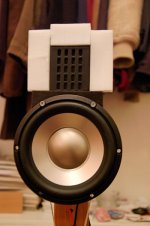
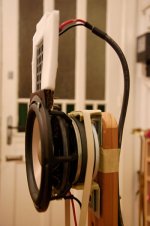
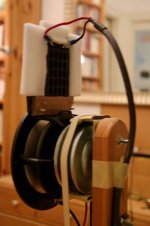
Is that an open cell foam? Doesn't look like it, in which case it would only act as a wider baffle on the Neo3. I think I tried something similar with my Neo3 PDR and didn't really like the results.
What do you get if you remove those foam pieces?
What do you get if you remove those foam pieces?
It's Basotect, an open cell foam with quite good acoustics damping characteristics. In fact, it helped a lot to tame the region around 7 kHz. So thanks for the suggestion, but the foam isn't the culprit, too...
I compared the measurements with the older ones of the single Neo3 in a different mounting scheme (on top of a long cardboard baffle, farther away from the stand), and those didn't show the irregularity. Photo is attached, measurements are shown in an earlier post.
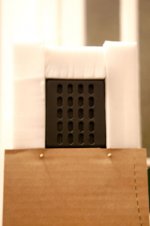
I compared the measurements with the older ones of the single Neo3 in a different mounting scheme (on top of a long cardboard baffle, farther away from the stand), and those didn't show the irregularity. Photo is attached, measurements are shown in an earlier post.

Your measurements are excellent agreement with Seas' published L16 data. I don't understand why so many of Seas' woofers leave the pistonic range around 500-700Hz but, as the distortion problems hint at, you're not seeing beaming---the dipole peak on a 5 inch is around 2kHz so you should get decent directivity through the crossover. If you want an aluminum cone dynamic woofer in a 5 inch that doesn't get all hot on axis you might try the Peerless 835024. I'd favor something with a response more like the 830656, though.
It's Basotect, an open cell foam with quite good acoustics damping characteristics. In fact, it helped a lot to tame the region around 7 kHz.
Hmm. Wonder what an equivalent product would be in the US. I tried wool felt, which helped with the 7-8kHz null, but it seemed to hurt the off-axis response at lower frequencies. I never came to a final conclusion on whether it helped or hurt more.
I should get the non-PDR Neo3 and measure those.
- Status
- Not open for further replies.
- Home
- Loudspeakers
- Multi-Way
- Driver evaluation for OB project
